Comprehensive Ratio Analysis Report: Shell PLC Financial Performance
VerifiedAdded on 2023/01/12
|16
|4686
|73
Report
AI Summary
This report presents a comprehensive financial analysis of Royal Dutch Shell PLC, focusing on the years 2018 and 2019. The analysis employs key performance indicators derived from ratio analysis, encompassing liquidity, profitability, efficiency, gearing, and market-related metrics. The report delves into specific ratios like the acid-test, current, and cash ratios to assess liquidity, and gross profit margin, operating profit margin, net profit margin, and cash flow margin to evaluate profitability. Efficiency is examined through operational ratios, while gearing and investment ratios provide insights into the company's financial structure and market performance. The report concludes by highlighting the importance of ratio analysis in understanding a company's financial health, while also cautioning against solely relying on these proportions without considering the size of operations. The analysis reveals Shell's performance improvements in several areas but also points out areas needing attention.
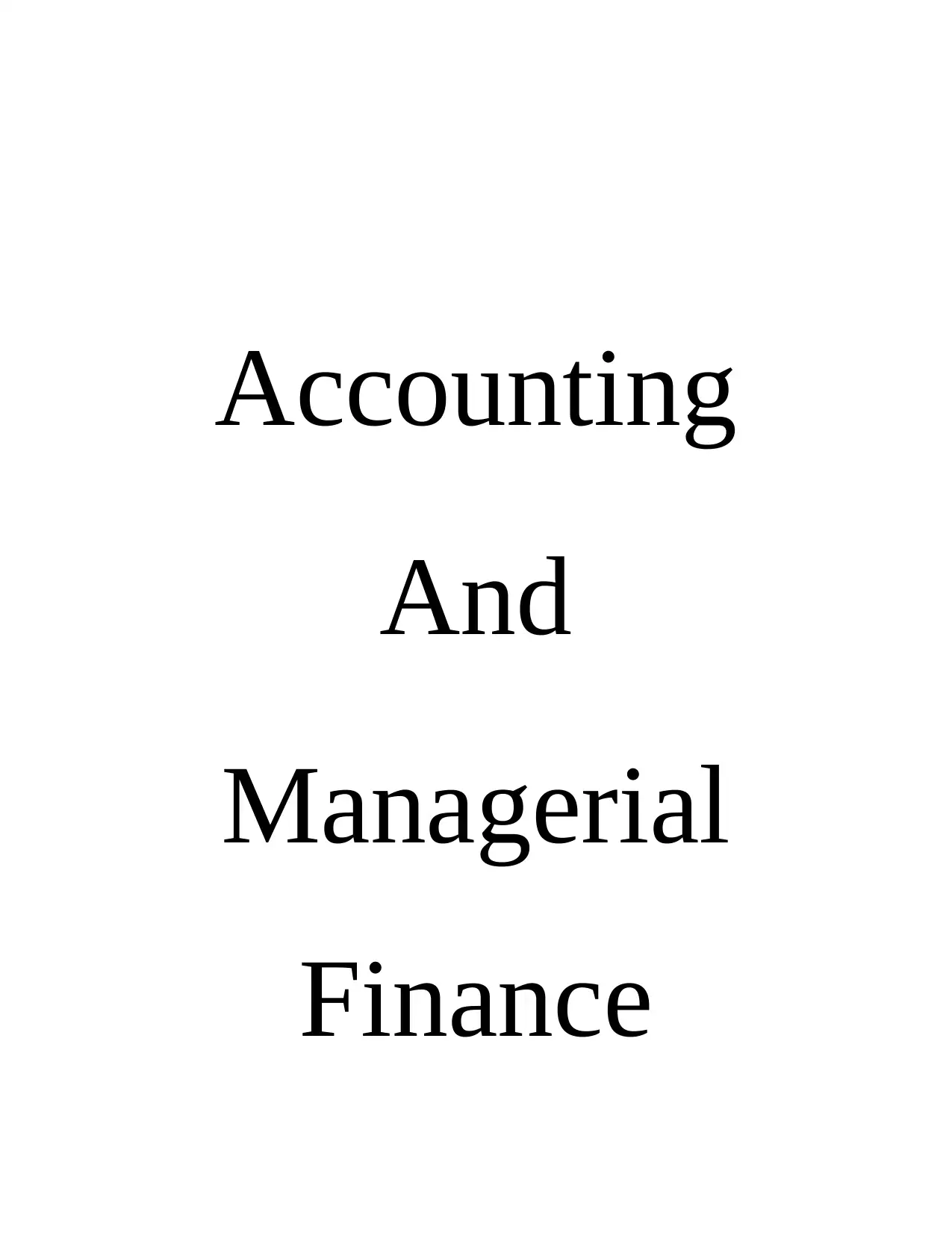
Accounting
And
Managerial
Finance
And
Managerial
Finance
Paraphrase This Document
Need a fresh take? Get an instant paraphrase of this document with our AI Paraphraser
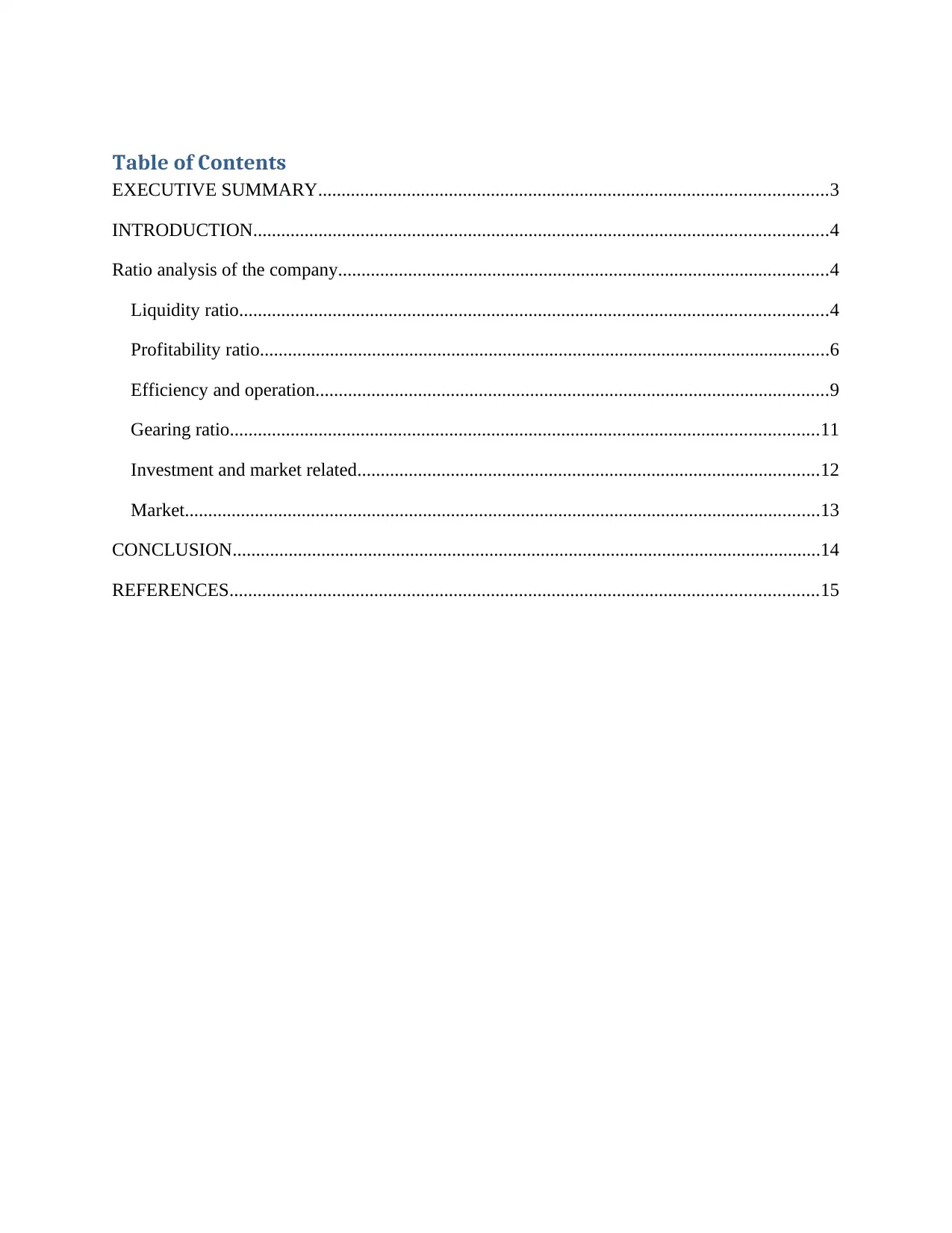
Table of Contents
EXECUTIVE SUMMARY.............................................................................................................3
INTRODUCTION...........................................................................................................................4
Ratio analysis of the company.........................................................................................................4
Liquidity ratio..............................................................................................................................4
Profitability ratio..........................................................................................................................6
Efficiency and operation..............................................................................................................9
Gearing ratio..............................................................................................................................11
Investment and market related...................................................................................................12
Market........................................................................................................................................13
CONCLUSION..............................................................................................................................14
REFERENCES..............................................................................................................................15
EXECUTIVE SUMMARY.............................................................................................................3
INTRODUCTION...........................................................................................................................4
Ratio analysis of the company.........................................................................................................4
Liquidity ratio..............................................................................................................................4
Profitability ratio..........................................................................................................................6
Efficiency and operation..............................................................................................................9
Gearing ratio..............................................................................................................................11
Investment and market related...................................................................................................12
Market........................................................................................................................................13
CONCLUSION..............................................................................................................................14
REFERENCES..............................................................................................................................15

EXECUTIVE SUMMARY
This project report consists of measurement of results of Royal Dutch Shell PLC for the two
consecutive years 2019 and 2018 through key performance indicators which is ratio analysis.
These analyses consists many ratios like liquidity, profit, gearing, investment and market.
Liquidity ratio shows how efficiently Royal Dutch Shell PLC can convert its current assets into
liquidity or cash. Profitability ratios show a company's overall efficiency and performance.
Ratios showing returns represent the firm's ability to measure overall efficiency to deliver returns
for its shareholders. The efficiency ratio is typically used to analyze how well a company uses its
assets and liabilities internally. An efficiency ratio can calculate the turnover of receivables,
repayment of liabilities, amount and utilization of equity, and general use of inventory and
machinery. A share is an inseparable unit of capital, giving ownership to the shareholder and
creating an ownership relationship between the company and the shareholder.
Price to income ratio is only an indication but before making investment decision it is necessary
to do a complete study, analysis, research of the market as well as knowledge of the industry and
business of the above category. Each of these measures is used differently, but jointly, they
present a very accurate financial picture of a publicly traded company. It is also recommended
that company should not blindly appraise its project or performance based on ratio analyses,
because these analyses only show proportion. It totally ignores the size of the operations.
This project report consists of measurement of results of Royal Dutch Shell PLC for the two
consecutive years 2019 and 2018 through key performance indicators which is ratio analysis.
These analyses consists many ratios like liquidity, profit, gearing, investment and market.
Liquidity ratio shows how efficiently Royal Dutch Shell PLC can convert its current assets into
liquidity or cash. Profitability ratios show a company's overall efficiency and performance.
Ratios showing returns represent the firm's ability to measure overall efficiency to deliver returns
for its shareholders. The efficiency ratio is typically used to analyze how well a company uses its
assets and liabilities internally. An efficiency ratio can calculate the turnover of receivables,
repayment of liabilities, amount and utilization of equity, and general use of inventory and
machinery. A share is an inseparable unit of capital, giving ownership to the shareholder and
creating an ownership relationship between the company and the shareholder.
Price to income ratio is only an indication but before making investment decision it is necessary
to do a complete study, analysis, research of the market as well as knowledge of the industry and
business of the above category. Each of these measures is used differently, but jointly, they
present a very accurate financial picture of a publicly traded company. It is also recommended
that company should not blindly appraise its project or performance based on ratio analyses,
because these analyses only show proportion. It totally ignores the size of the operations.
⊘ This is a preview!⊘
Do you want full access?
Subscribe today to unlock all pages.

Trusted by 1+ million students worldwide
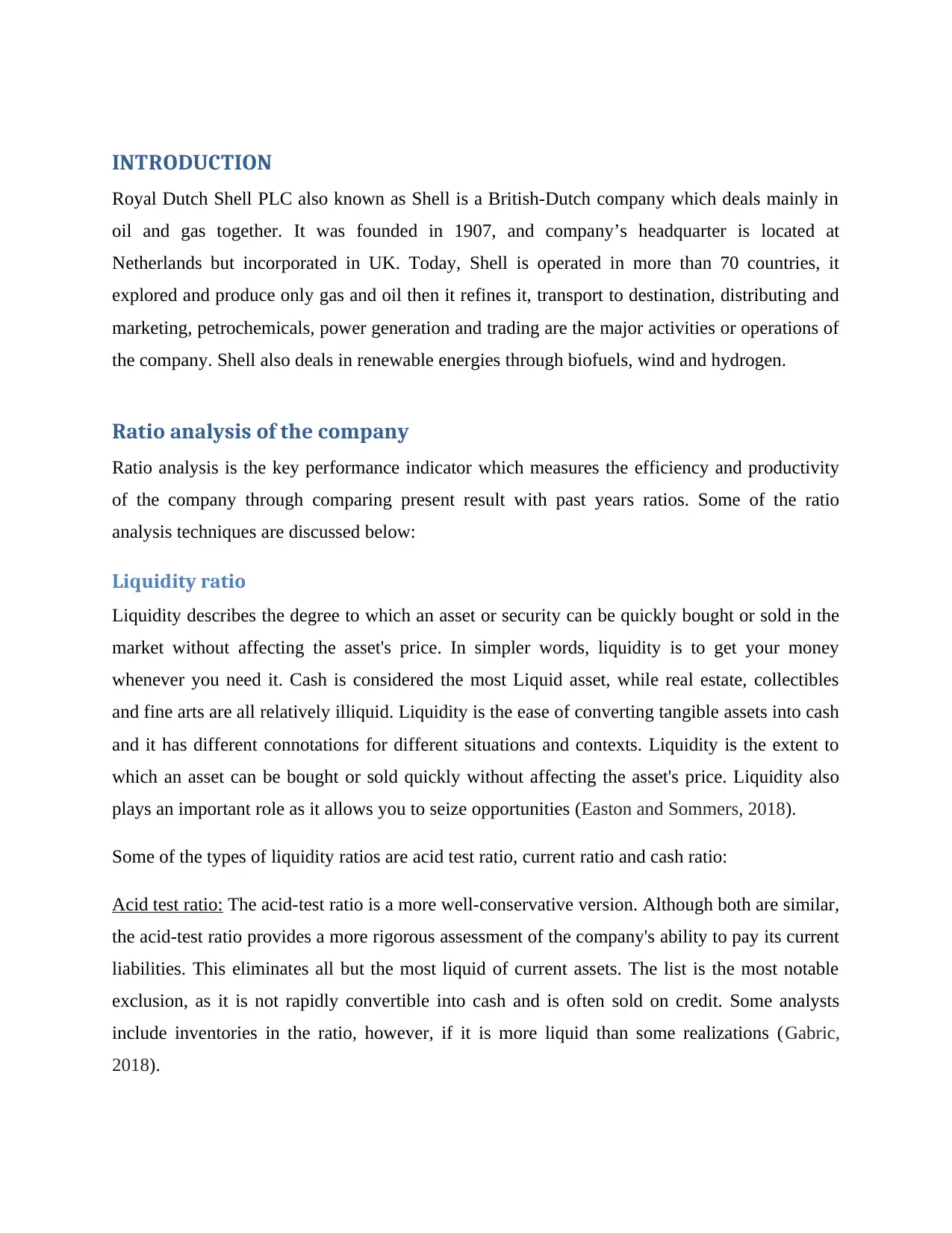
INTRODUCTION
Royal Dutch Shell PLC also known as Shell is a British-Dutch company which deals mainly in
oil and gas together. It was founded in 1907, and company’s headquarter is located at
Netherlands but incorporated in UK. Today, Shell is operated in more than 70 countries, it
explored and produce only gas and oil then it refines it, transport to destination, distributing and
marketing, petrochemicals, power generation and trading are the major activities or operations of
the company. Shell also deals in renewable energies through biofuels, wind and hydrogen.
Ratio analysis of the company
Ratio analysis is the key performance indicator which measures the efficiency and productivity
of the company through comparing present result with past years ratios. Some of the ratio
analysis techniques are discussed below:
Liquidity ratio
Liquidity describes the degree to which an asset or security can be quickly bought or sold in the
market without affecting the asset's price. In simpler words, liquidity is to get your money
whenever you need it. Cash is considered the most Liquid asset, while real estate, collectibles
and fine arts are all relatively illiquid. Liquidity is the ease of converting tangible assets into cash
and it has different connotations for different situations and contexts. Liquidity is the extent to
which an asset can be bought or sold quickly without affecting the asset's price. Liquidity also
plays an important role as it allows you to seize opportunities (Easton and Sommers, 2018).
Some of the types of liquidity ratios are acid test ratio, current ratio and cash ratio:
Acid test ratio: The acid-test ratio is a more well-conservative version. Although both are similar,
the acid-test ratio provides a more rigorous assessment of the company's ability to pay its current
liabilities. This eliminates all but the most liquid of current assets. The list is the most notable
exclusion, as it is not rapidly convertible into cash and is often sold on credit. Some analysts
include inventories in the ratio, however, if it is more liquid than some realizations (Gabric,
2018).
Royal Dutch Shell PLC also known as Shell is a British-Dutch company which deals mainly in
oil and gas together. It was founded in 1907, and company’s headquarter is located at
Netherlands but incorporated in UK. Today, Shell is operated in more than 70 countries, it
explored and produce only gas and oil then it refines it, transport to destination, distributing and
marketing, petrochemicals, power generation and trading are the major activities or operations of
the company. Shell also deals in renewable energies through biofuels, wind and hydrogen.
Ratio analysis of the company
Ratio analysis is the key performance indicator which measures the efficiency and productivity
of the company through comparing present result with past years ratios. Some of the ratio
analysis techniques are discussed below:
Liquidity ratio
Liquidity describes the degree to which an asset or security can be quickly bought or sold in the
market without affecting the asset's price. In simpler words, liquidity is to get your money
whenever you need it. Cash is considered the most Liquid asset, while real estate, collectibles
and fine arts are all relatively illiquid. Liquidity is the ease of converting tangible assets into cash
and it has different connotations for different situations and contexts. Liquidity is the extent to
which an asset can be bought or sold quickly without affecting the asset's price. Liquidity also
plays an important role as it allows you to seize opportunities (Easton and Sommers, 2018).
Some of the types of liquidity ratios are acid test ratio, current ratio and cash ratio:
Acid test ratio: The acid-test ratio is a more well-conservative version. Although both are similar,
the acid-test ratio provides a more rigorous assessment of the company's ability to pay its current
liabilities. This eliminates all but the most liquid of current assets. The list is the most notable
exclusion, as it is not rapidly convertible into cash and is often sold on credit. Some analysts
include inventories in the ratio, however, if it is more liquid than some realizations (Gabric,
2018).
Paraphrase This Document
Need a fresh take? Get an instant paraphrase of this document with our AI Paraphraser
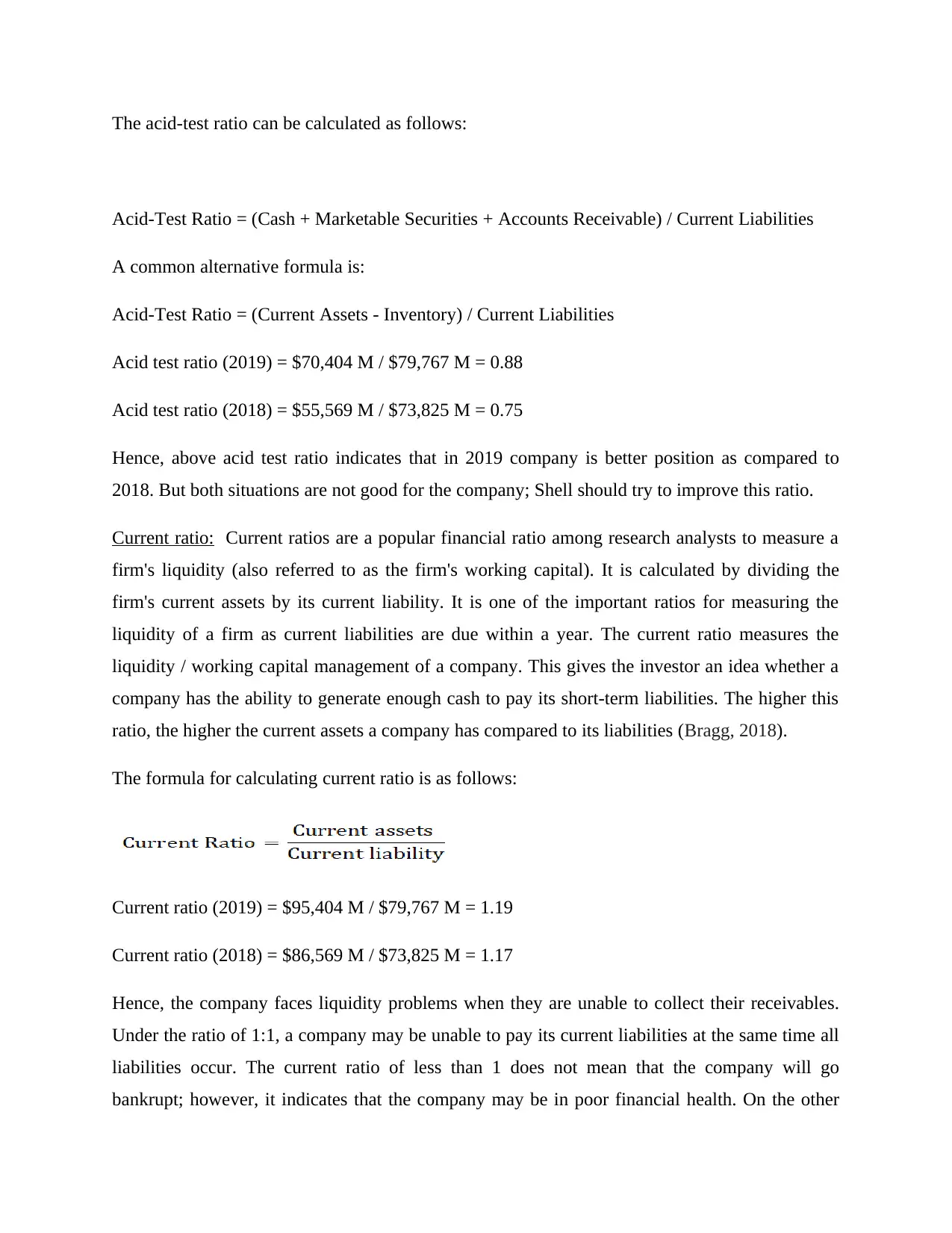
The acid-test ratio can be calculated as follows:
Acid-Test Ratio = (Cash + Marketable Securities + Accounts Receivable) / Current Liabilities
A common alternative formula is:
Acid-Test Ratio = (Current Assets - Inventory) / Current Liabilities
Acid test ratio (2019) = $70,404 M / $79,767 M = 0.88
Acid test ratio (2018) = $55,569 M / $73,825 M = 0.75
Hence, above acid test ratio indicates that in 2019 company is better position as compared to
2018. But both situations are not good for the company; Shell should try to improve this ratio.
Current ratio: Current ratios are a popular financial ratio among research analysts to measure a
firm's liquidity (also referred to as the firm's working capital). It is calculated by dividing the
firm's current assets by its current liability. It is one of the important ratios for measuring the
liquidity of a firm as current liabilities are due within a year. The current ratio measures the
liquidity / working capital management of a company. This gives the investor an idea whether a
company has the ability to generate enough cash to pay its short-term liabilities. The higher this
ratio, the higher the current assets a company has compared to its liabilities (Bragg, 2018).
The formula for calculating current ratio is as follows:
Current ratio (2019) = $95,404 M / $79,767 M = 1.19
Current ratio (2018) = $86,569 M / $73,825 M = 1.17
Hence, the company faces liquidity problems when they are unable to collect their receivables.
Under the ratio of 1:1, a company may be unable to pay its current liabilities at the same time all
liabilities occur. The current ratio of less than 1 does not mean that the company will go
bankrupt; however, it indicates that the company may be in poor financial health. On the other
Acid-Test Ratio = (Cash + Marketable Securities + Accounts Receivable) / Current Liabilities
A common alternative formula is:
Acid-Test Ratio = (Current Assets - Inventory) / Current Liabilities
Acid test ratio (2019) = $70,404 M / $79,767 M = 0.88
Acid test ratio (2018) = $55,569 M / $73,825 M = 0.75
Hence, above acid test ratio indicates that in 2019 company is better position as compared to
2018. But both situations are not good for the company; Shell should try to improve this ratio.
Current ratio: Current ratios are a popular financial ratio among research analysts to measure a
firm's liquidity (also referred to as the firm's working capital). It is calculated by dividing the
firm's current assets by its current liability. It is one of the important ratios for measuring the
liquidity of a firm as current liabilities are due within a year. The current ratio measures the
liquidity / working capital management of a company. This gives the investor an idea whether a
company has the ability to generate enough cash to pay its short-term liabilities. The higher this
ratio, the higher the current assets a company has compared to its liabilities (Bragg, 2018).
The formula for calculating current ratio is as follows:
Current ratio (2019) = $95,404 M / $79,767 M = 1.19
Current ratio (2018) = $86,569 M / $73,825 M = 1.17
Hence, the company faces liquidity problems when they are unable to collect their receivables.
Under the ratio of 1:1, a company may be unable to pay its current liabilities at the same time all
liabilities occur. The current ratio of less than 1 does not mean that the company will go
bankrupt; however, it indicates that the company may be in poor financial health. On the other
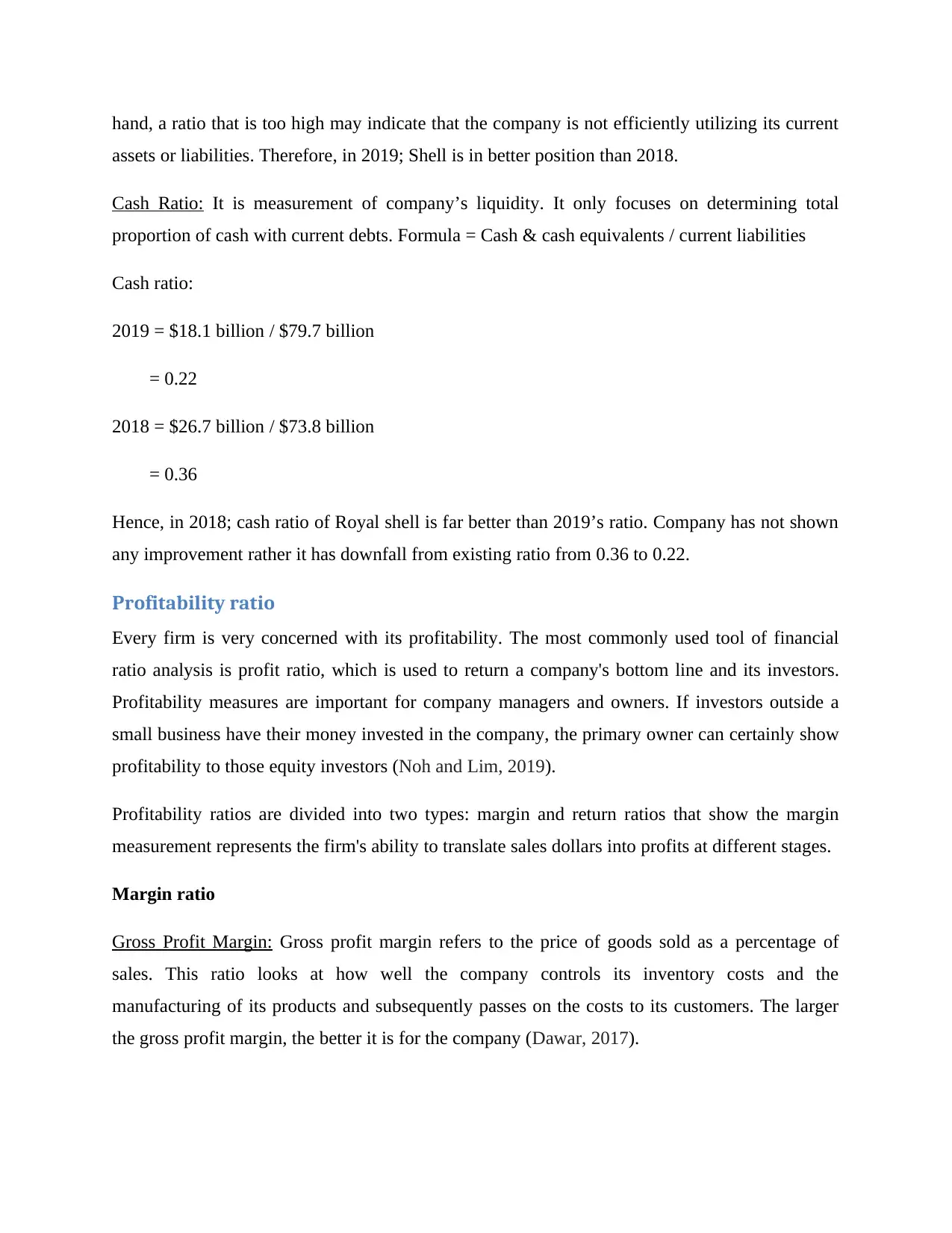
hand, a ratio that is too high may indicate that the company is not efficiently utilizing its current
assets or liabilities. Therefore, in 2019; Shell is in better position than 2018.
Cash Ratio: It is measurement of company’s liquidity. It only focuses on determining total
proportion of cash with current debts. Formula = Cash & cash equivalents / current liabilities
Cash ratio:
2019 = $18.1 billion / $79.7 billion
= 0.22
2018 = $26.7 billion / $73.8 billion
= 0.36
Hence, in 2018; cash ratio of Royal shell is far better than 2019’s ratio. Company has not shown
any improvement rather it has downfall from existing ratio from 0.36 to 0.22.
Profitability ratio
Every firm is very concerned with its profitability. The most commonly used tool of financial
ratio analysis is profit ratio, which is used to return a company's bottom line and its investors.
Profitability measures are important for company managers and owners. If investors outside a
small business have their money invested in the company, the primary owner can certainly show
profitability to those equity investors (Noh and Lim, 2019).
Profitability ratios are divided into two types: margin and return ratios that show the margin
measurement represents the firm's ability to translate sales dollars into profits at different stages.
Margin ratio
Gross Profit Margin: Gross profit margin refers to the price of goods sold as a percentage of
sales. This ratio looks at how well the company controls its inventory costs and the
manufacturing of its products and subsequently passes on the costs to its customers. The larger
the gross profit margin, the better it is for the company (Dawar, 2017).
assets or liabilities. Therefore, in 2019; Shell is in better position than 2018.
Cash Ratio: It is measurement of company’s liquidity. It only focuses on determining total
proportion of cash with current debts. Formula = Cash & cash equivalents / current liabilities
Cash ratio:
2019 = $18.1 billion / $79.7 billion
= 0.22
2018 = $26.7 billion / $73.8 billion
= 0.36
Hence, in 2018; cash ratio of Royal shell is far better than 2019’s ratio. Company has not shown
any improvement rather it has downfall from existing ratio from 0.36 to 0.22.
Profitability ratio
Every firm is very concerned with its profitability. The most commonly used tool of financial
ratio analysis is profit ratio, which is used to return a company's bottom line and its investors.
Profitability measures are important for company managers and owners. If investors outside a
small business have their money invested in the company, the primary owner can certainly show
profitability to those equity investors (Noh and Lim, 2019).
Profitability ratios are divided into two types: margin and return ratios that show the margin
measurement represents the firm's ability to translate sales dollars into profits at different stages.
Margin ratio
Gross Profit Margin: Gross profit margin refers to the price of goods sold as a percentage of
sales. This ratio looks at how well the company controls its inventory costs and the
manufacturing of its products and subsequently passes on the costs to its customers. The larger
the gross profit margin, the better it is for the company (Dawar, 2017).
⊘ This is a preview!⊘
Do you want full access?
Subscribe today to unlock all pages.

Trusted by 1+ million students worldwide
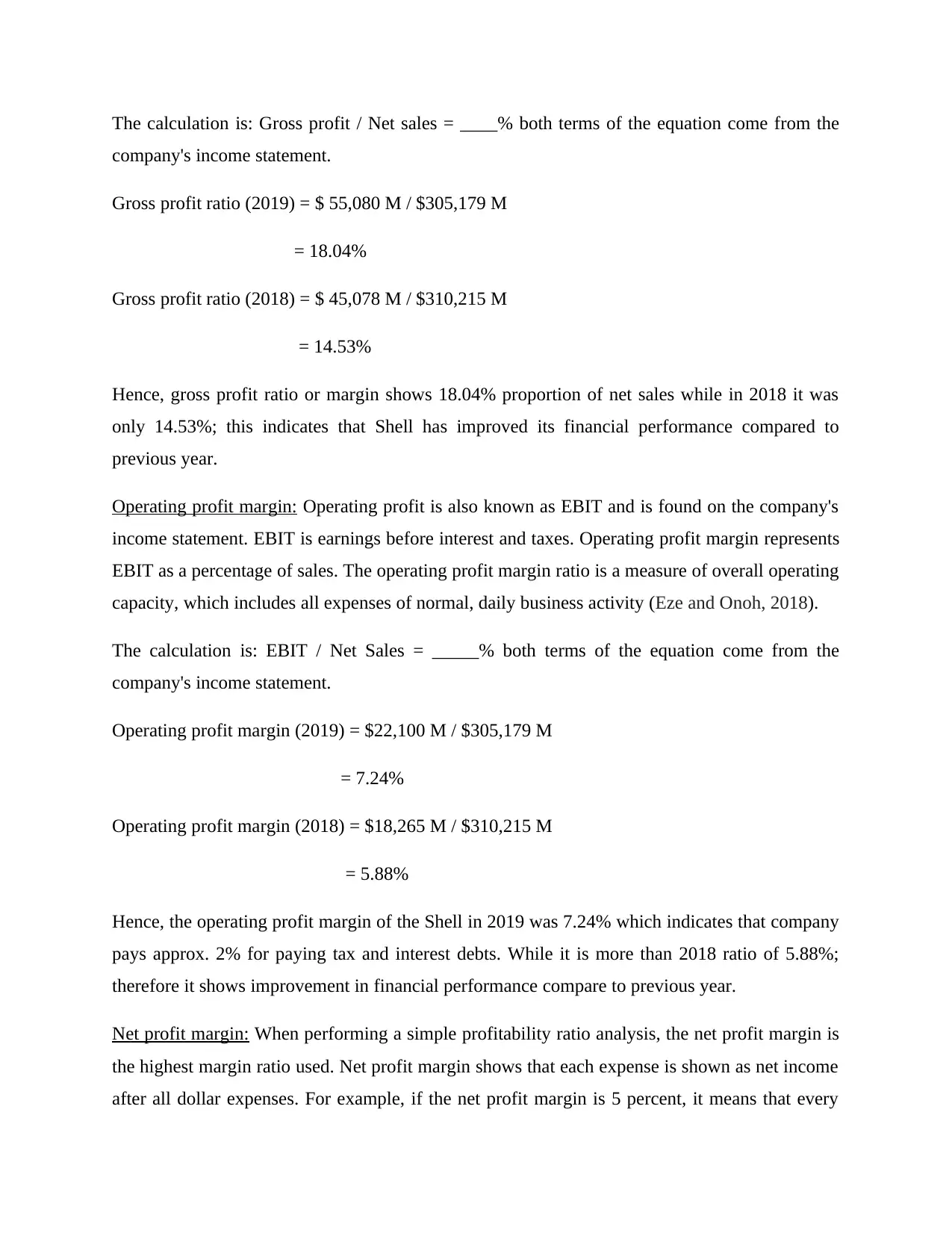
The calculation is: Gross profit / Net sales = ____% both terms of the equation come from the
company's income statement.
Gross profit ratio (2019) = $ 55,080 M / $305,179 M
= 18.04%
Gross profit ratio (2018) = $ 45,078 M / $310,215 M
= 14.53%
Hence, gross profit ratio or margin shows 18.04% proportion of net sales while in 2018 it was
only 14.53%; this indicates that Shell has improved its financial performance compared to
previous year.
Operating profit margin: Operating profit is also known as EBIT and is found on the company's
income statement. EBIT is earnings before interest and taxes. Operating profit margin represents
EBIT as a percentage of sales. The operating profit margin ratio is a measure of overall operating
capacity, which includes all expenses of normal, daily business activity (Eze and Onoh, 2018).
The calculation is: EBIT / Net Sales = _____% both terms of the equation come from the
company's income statement.
Operating profit margin (2019) = $22,100 M / $305,179 M
= 7.24%
Operating profit margin (2018) = $18,265 M / $310,215 M
= 5.88%
Hence, the operating profit margin of the Shell in 2019 was 7.24% which indicates that company
pays approx. 2% for paying tax and interest debts. While it is more than 2018 ratio of 5.88%;
therefore it shows improvement in financial performance compare to previous year.
Net profit margin: When performing a simple profitability ratio analysis, the net profit margin is
the highest margin ratio used. Net profit margin shows that each expense is shown as net income
after all dollar expenses. For example, if the net profit margin is 5 percent, it means that every
company's income statement.
Gross profit ratio (2019) = $ 55,080 M / $305,179 M
= 18.04%
Gross profit ratio (2018) = $ 45,078 M / $310,215 M
= 14.53%
Hence, gross profit ratio or margin shows 18.04% proportion of net sales while in 2018 it was
only 14.53%; this indicates that Shell has improved its financial performance compared to
previous year.
Operating profit margin: Operating profit is also known as EBIT and is found on the company's
income statement. EBIT is earnings before interest and taxes. Operating profit margin represents
EBIT as a percentage of sales. The operating profit margin ratio is a measure of overall operating
capacity, which includes all expenses of normal, daily business activity (Eze and Onoh, 2018).
The calculation is: EBIT / Net Sales = _____% both terms of the equation come from the
company's income statement.
Operating profit margin (2019) = $22,100 M / $305,179 M
= 7.24%
Operating profit margin (2018) = $18,265 M / $310,215 M
= 5.88%
Hence, the operating profit margin of the Shell in 2019 was 7.24% which indicates that company
pays approx. 2% for paying tax and interest debts. While it is more than 2018 ratio of 5.88%;
therefore it shows improvement in financial performance compare to previous year.
Net profit margin: When performing a simple profitability ratio analysis, the net profit margin is
the highest margin ratio used. Net profit margin shows that each expense is shown as net income
after all dollar expenses. For example, if the net profit margin is 5 percent, it means that every
Paraphrase This Document
Need a fresh take? Get an instant paraphrase of this document with our AI Paraphraser
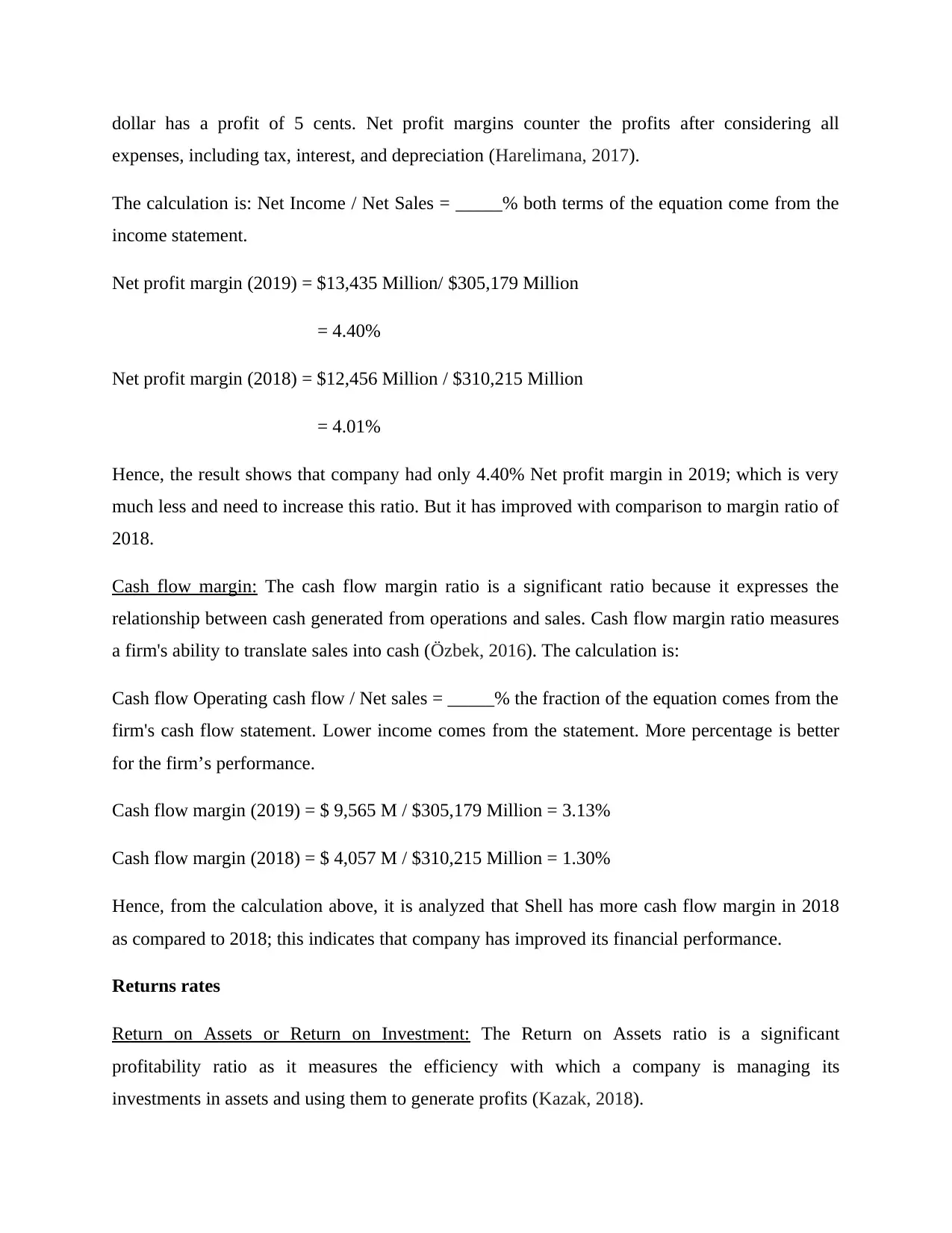
dollar has a profit of 5 cents. Net profit margins counter the profits after considering all
expenses, including tax, interest, and depreciation (Harelimana, 2017).
The calculation is: Net Income / Net Sales = _____% both terms of the equation come from the
income statement.
Net profit margin (2019) = $13,435 Million/ $305,179 Million
= 4.40%
Net profit margin (2018) = $12,456 Million / $310,215 Million
= 4.01%
Hence, the result shows that company had only 4.40% Net profit margin in 2019; which is very
much less and need to increase this ratio. But it has improved with comparison to margin ratio of
2018.
Cash flow margin: The cash flow margin ratio is a significant ratio because it expresses the
relationship between cash generated from operations and sales. Cash flow margin ratio measures
a firm's ability to translate sales into cash (Özbek, 2016). The calculation is:
Cash flow Operating cash flow / Net sales = _____% the fraction of the equation comes from the
firm's cash flow statement. Lower income comes from the statement. More percentage is better
for the firm’s performance.
Cash flow margin (2019) = $ 9,565 M / $305,179 Million = 3.13%
Cash flow margin (2018) = $ 4,057 M / $310,215 Million = 1.30%
Hence, from the calculation above, it is analyzed that Shell has more cash flow margin in 2018
as compared to 2018; this indicates that company has improved its financial performance.
Returns rates
Return on Assets or Return on Investment: The Return on Assets ratio is a significant
profitability ratio as it measures the efficiency with which a company is managing its
investments in assets and using them to generate profits (Kazak, 2018).
expenses, including tax, interest, and depreciation (Harelimana, 2017).
The calculation is: Net Income / Net Sales = _____% both terms of the equation come from the
income statement.
Net profit margin (2019) = $13,435 Million/ $305,179 Million
= 4.40%
Net profit margin (2018) = $12,456 Million / $310,215 Million
= 4.01%
Hence, the result shows that company had only 4.40% Net profit margin in 2019; which is very
much less and need to increase this ratio. But it has improved with comparison to margin ratio of
2018.
Cash flow margin: The cash flow margin ratio is a significant ratio because it expresses the
relationship between cash generated from operations and sales. Cash flow margin ratio measures
a firm's ability to translate sales into cash (Özbek, 2016). The calculation is:
Cash flow Operating cash flow / Net sales = _____% the fraction of the equation comes from the
firm's cash flow statement. Lower income comes from the statement. More percentage is better
for the firm’s performance.
Cash flow margin (2019) = $ 9,565 M / $305,179 Million = 3.13%
Cash flow margin (2018) = $ 4,057 M / $310,215 Million = 1.30%
Hence, from the calculation above, it is analyzed that Shell has more cash flow margin in 2018
as compared to 2018; this indicates that company has improved its financial performance.
Returns rates
Return on Assets or Return on Investment: The Return on Assets ratio is a significant
profitability ratio as it measures the efficiency with which a company is managing its
investments in assets and using them to generate profits (Kazak, 2018).

Calculated for Return on Assets Ratio: Net Income / Total Assets = _____% Net Income is
derived from the Income Statement and Total Assets is taken from the Balance Sheet. The higher
the percentage, the better it is, because it means that the company is doing a good job using its
assets to increase sales.
Return on Investment (2019) = $13,435 M / $407,097 M = 3.30%
Return on Investment (2018) = $12,456 M / $411,275 M = 3.02%
Royal shell has shown better performance in 2019 compared to previous year in terms of more
return on its total assets (current assets + fixed assets). The reason behind this improvement is
increase in net income and decrease in total assets; due to sale of properties.
Return on equity: Return on equity ratio is probably the most important of all financial ratios for
investors in the company. It measures the return on the money that has been put into the
company by the investors. This ratio is what the potential investors look for if they invest in the
company (Myšková and Hájek, 2017).
The calculation is: Net income / shareholder's equity = _____% Net income comes from the
income statement and shareholder's equity comes from the balance sheet.
Return on equity (2019) = $13,435 M / $ 194,356 M = 6.91%
Return on equity (2018) = $12,456 M / $ 186,646 M = 6.67%
As the calculation above shows more return on equity capital, due to increased in net income
with more proportion to increase in equity capital from 2018 to 2019. This indicates
improvement in financial performance of the firm.
Cash Return on Assets: Cash return on assets ratio is typically used only in more advanced
profitability ratio analysis. It is used as a comparison of return on assets because it is a
comparison of cash to this ratio because of assets. Returns have been made on accrual basis.
Cash is necessary for future investment (Tinkelman and Fan, 2018).
derived from the Income Statement and Total Assets is taken from the Balance Sheet. The higher
the percentage, the better it is, because it means that the company is doing a good job using its
assets to increase sales.
Return on Investment (2019) = $13,435 M / $407,097 M = 3.30%
Return on Investment (2018) = $12,456 M / $411,275 M = 3.02%
Royal shell has shown better performance in 2019 compared to previous year in terms of more
return on its total assets (current assets + fixed assets). The reason behind this improvement is
increase in net income and decrease in total assets; due to sale of properties.
Return on equity: Return on equity ratio is probably the most important of all financial ratios for
investors in the company. It measures the return on the money that has been put into the
company by the investors. This ratio is what the potential investors look for if they invest in the
company (Myšková and Hájek, 2017).
The calculation is: Net income / shareholder's equity = _____% Net income comes from the
income statement and shareholder's equity comes from the balance sheet.
Return on equity (2019) = $13,435 M / $ 194,356 M = 6.91%
Return on equity (2018) = $12,456 M / $ 186,646 M = 6.67%
As the calculation above shows more return on equity capital, due to increased in net income
with more proportion to increase in equity capital from 2018 to 2019. This indicates
improvement in financial performance of the firm.
Cash Return on Assets: Cash return on assets ratio is typically used only in more advanced
profitability ratio analysis. It is used as a comparison of return on assets because it is a
comparison of cash to this ratio because of assets. Returns have been made on accrual basis.
Cash is necessary for future investment (Tinkelman and Fan, 2018).
⊘ This is a preview!⊘
Do you want full access?
Subscribe today to unlock all pages.

Trusted by 1+ million students worldwide

The calculation is: Cash flow from operating activities / total assets = _____% share is taken
from the statement of cash flow and everything from the balance sheet. The higher the
percentage, the better it is.
Cash return on Assets (2019) = $22,100 M / $407,097 M = 5.42%
Cash return on Assets (2018) = $18,265 M / $ 411,275 M = 4.44%
This calculation shows proportion of cash earned by Royal Shell from available total assets. The
figure indicates that; company has shown improvement in given ratio as compared with previous
year.
Efficiency and operation
The efficiency ratio, also known as the activity ratio, is used by analysts to measure the
performance of a company's short-term or current performance. Some of the efficiency and
operation ratios are discussed below:
Accounts Receivable Turnover Ratio: To calculate a company's accounts receivable turnover
ratio, start with net receivable sales for a set period, then divide by the average accounts
receivable balance for the period (Kendirli, Cankaya and Cagatay, 2017). The formula for
accounts receivable turnover ratio:
Accounts receivable turnover ratio (2019) = $180,475 / $49,869 = 3.61 times
Accounts receivable turnover ratio (2018) = $200,156 / $53,645 = 3.73 times
Hence, it is clear that; in 2019 average receivables is less than 2018, which indicates less risk for
the Shell of bad debts. Higher ratios are indications that the company is more efficient at
collecting on its receivables. A lower ratio may mean that the company struggles to achieve
receivables and may have cash flow problems.
from the statement of cash flow and everything from the balance sheet. The higher the
percentage, the better it is.
Cash return on Assets (2019) = $22,100 M / $407,097 M = 5.42%
Cash return on Assets (2018) = $18,265 M / $ 411,275 M = 4.44%
This calculation shows proportion of cash earned by Royal Shell from available total assets. The
figure indicates that; company has shown improvement in given ratio as compared with previous
year.
Efficiency and operation
The efficiency ratio, also known as the activity ratio, is used by analysts to measure the
performance of a company's short-term or current performance. Some of the efficiency and
operation ratios are discussed below:
Accounts Receivable Turnover Ratio: To calculate a company's accounts receivable turnover
ratio, start with net receivable sales for a set period, then divide by the average accounts
receivable balance for the period (Kendirli, Cankaya and Cagatay, 2017). The formula for
accounts receivable turnover ratio:
Accounts receivable turnover ratio (2019) = $180,475 / $49,869 = 3.61 times
Accounts receivable turnover ratio (2018) = $200,156 / $53,645 = 3.73 times
Hence, it is clear that; in 2019 average receivables is less than 2018, which indicates less risk for
the Shell of bad debts. Higher ratios are indications that the company is more efficient at
collecting on its receivables. A lower ratio may mean that the company struggles to achieve
receivables and may have cash flow problems.
Paraphrase This Document
Need a fresh take? Get an instant paraphrase of this document with our AI Paraphraser
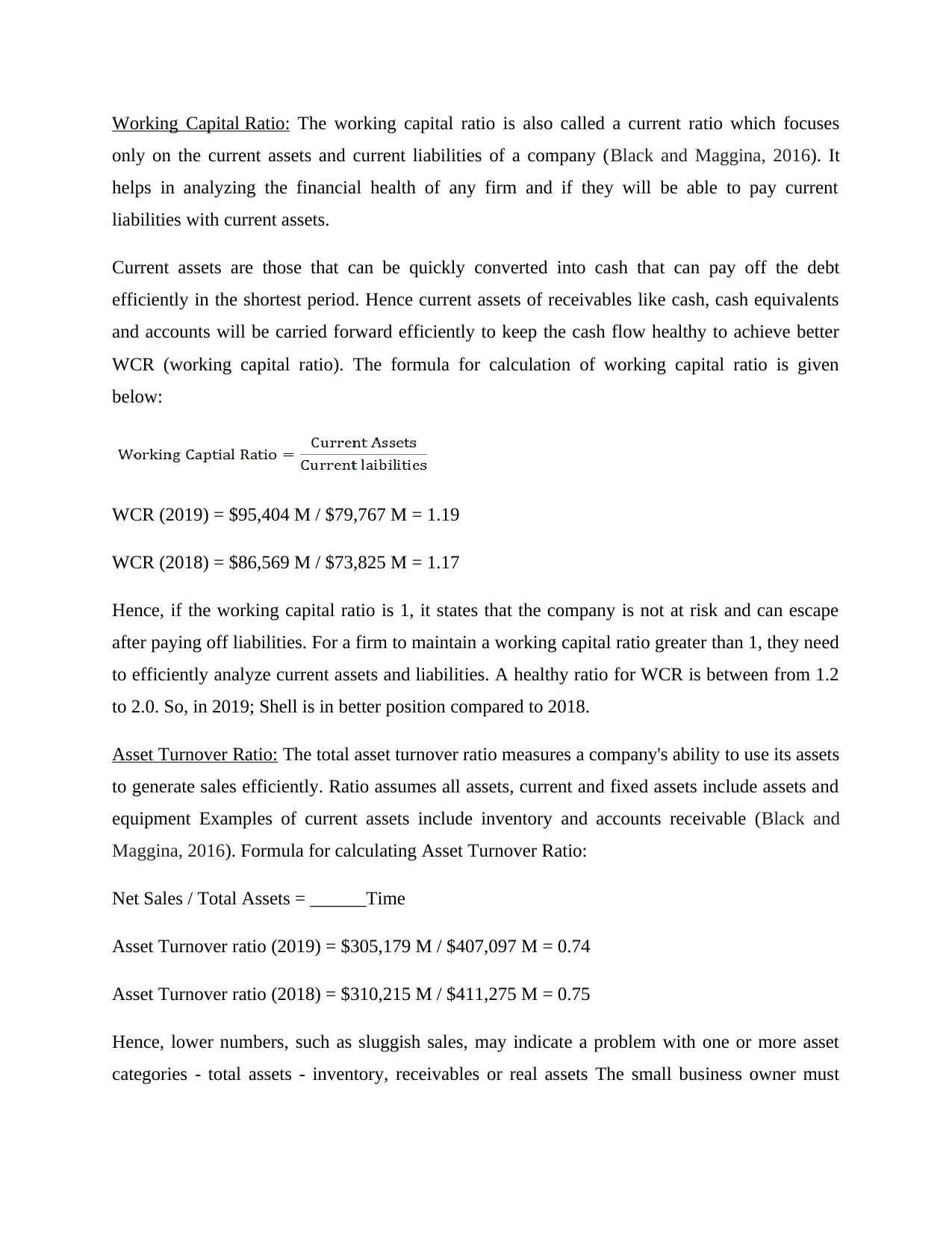
Working Capital Ratio: The working capital ratio is also called a current ratio which focuses
only on the current assets and current liabilities of a company (Black and Maggina, 2016). It
helps in analyzing the financial health of any firm and if they will be able to pay current
liabilities with current assets.
Current assets are those that can be quickly converted into cash that can pay off the debt
efficiently in the shortest period. Hence current assets of receivables like cash, cash equivalents
and accounts will be carried forward efficiently to keep the cash flow healthy to achieve better
WCR (working capital ratio). The formula for calculation of working capital ratio is given
below:
WCR (2019) = $95,404 M / $79,767 M = 1.19
WCR (2018) = $86,569 M / $73,825 M = 1.17
Hence, if the working capital ratio is 1, it states that the company is not at risk and can escape
after paying off liabilities. For a firm to maintain a working capital ratio greater than 1, they need
to efficiently analyze current assets and liabilities. A healthy ratio for WCR is between from 1.2
to 2.0. So, in 2019; Shell is in better position compared to 2018.
Asset Turnover Ratio: The total asset turnover ratio measures a company's ability to use its assets
to generate sales efficiently. Ratio assumes all assets, current and fixed assets include assets and
equipment Examples of current assets include inventory and accounts receivable (Black and
Maggina, 2016). Formula for calculating Asset Turnover Ratio:
Net Sales / Total Assets = ______Time
Asset Turnover ratio (2019) = $305,179 M / $407,097 M = 0.74
Asset Turnover ratio (2018) = $310,215 M / $411,275 M = 0.75
Hence, lower numbers, such as sluggish sales, may indicate a problem with one or more asset
categories - total assets - inventory, receivables or real assets The small business owner must
only on the current assets and current liabilities of a company (Black and Maggina, 2016). It
helps in analyzing the financial health of any firm and if they will be able to pay current
liabilities with current assets.
Current assets are those that can be quickly converted into cash that can pay off the debt
efficiently in the shortest period. Hence current assets of receivables like cash, cash equivalents
and accounts will be carried forward efficiently to keep the cash flow healthy to achieve better
WCR (working capital ratio). The formula for calculation of working capital ratio is given
below:
WCR (2019) = $95,404 M / $79,767 M = 1.19
WCR (2018) = $86,569 M / $73,825 M = 1.17
Hence, if the working capital ratio is 1, it states that the company is not at risk and can escape
after paying off liabilities. For a firm to maintain a working capital ratio greater than 1, they need
to efficiently analyze current assets and liabilities. A healthy ratio for WCR is between from 1.2
to 2.0. So, in 2019; Shell is in better position compared to 2018.
Asset Turnover Ratio: The total asset turnover ratio measures a company's ability to use its assets
to generate sales efficiently. Ratio assumes all assets, current and fixed assets include assets and
equipment Examples of current assets include inventory and accounts receivable (Black and
Maggina, 2016). Formula for calculating Asset Turnover Ratio:
Net Sales / Total Assets = ______Time
Asset Turnover ratio (2019) = $305,179 M / $407,097 M = 0.74
Asset Turnover ratio (2018) = $310,215 M / $411,275 M = 0.75
Hence, lower numbers, such as sluggish sales, may indicate a problem with one or more asset
categories - total assets - inventory, receivables or real assets The small business owner must
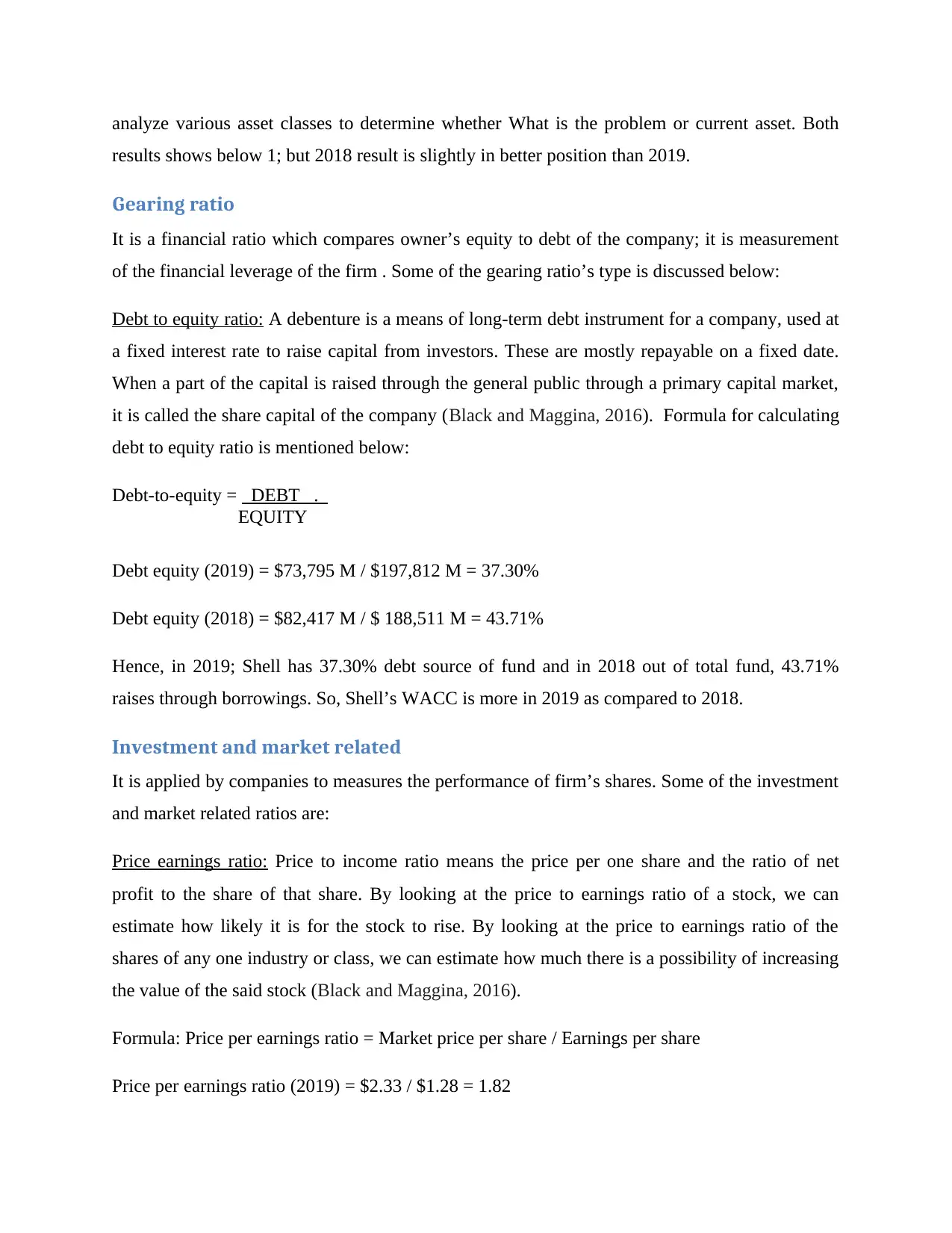
analyze various asset classes to determine whether What is the problem or current asset. Both
results shows below 1; but 2018 result is slightly in better position than 2019.
Gearing ratio
It is a financial ratio which compares owner’s equity to debt of the company; it is measurement
of the financial leverage of the firm . Some of the gearing ratio’s type is discussed below:
Debt to equity ratio: A debenture is a means of long-term debt instrument for a company, used at
a fixed interest rate to raise capital from investors. These are mostly repayable on a fixed date.
When a part of the capital is raised through the general public through a primary capital market,
it is called the share capital of the company (Black and Maggina, 2016). Formula for calculating
debt to equity ratio is mentioned below:
Debt-to-equity = DEBT .
EQUITY
Debt equity (2019) = $73,795 M / $197,812 M = 37.30%
Debt equity (2018) = $82,417 M / $ 188,511 M = 43.71%
Hence, in 2019; Shell has 37.30% debt source of fund and in 2018 out of total fund, 43.71%
raises through borrowings. So, Shell’s WACC is more in 2019 as compared to 2018.
Investment and market related
It is applied by companies to measures the performance of firm’s shares. Some of the investment
and market related ratios are:
Price earnings ratio: Price to income ratio means the price per one share and the ratio of net
profit to the share of that share. By looking at the price to earnings ratio of a stock, we can
estimate how likely it is for the stock to rise. By looking at the price to earnings ratio of the
shares of any one industry or class, we can estimate how much there is a possibility of increasing
the value of the said stock (Black and Maggina, 2016).
Formula: Price per earnings ratio = Market price per share / Earnings per share
Price per earnings ratio (2019) = $2.33 / $1.28 = 1.82
results shows below 1; but 2018 result is slightly in better position than 2019.
Gearing ratio
It is a financial ratio which compares owner’s equity to debt of the company; it is measurement
of the financial leverage of the firm . Some of the gearing ratio’s type is discussed below:
Debt to equity ratio: A debenture is a means of long-term debt instrument for a company, used at
a fixed interest rate to raise capital from investors. These are mostly repayable on a fixed date.
When a part of the capital is raised through the general public through a primary capital market,
it is called the share capital of the company (Black and Maggina, 2016). Formula for calculating
debt to equity ratio is mentioned below:
Debt-to-equity = DEBT .
EQUITY
Debt equity (2019) = $73,795 M / $197,812 M = 37.30%
Debt equity (2018) = $82,417 M / $ 188,511 M = 43.71%
Hence, in 2019; Shell has 37.30% debt source of fund and in 2018 out of total fund, 43.71%
raises through borrowings. So, Shell’s WACC is more in 2019 as compared to 2018.
Investment and market related
It is applied by companies to measures the performance of firm’s shares. Some of the investment
and market related ratios are:
Price earnings ratio: Price to income ratio means the price per one share and the ratio of net
profit to the share of that share. By looking at the price to earnings ratio of a stock, we can
estimate how likely it is for the stock to rise. By looking at the price to earnings ratio of the
shares of any one industry or class, we can estimate how much there is a possibility of increasing
the value of the said stock (Black and Maggina, 2016).
Formula: Price per earnings ratio = Market price per share / Earnings per share
Price per earnings ratio (2019) = $2.33 / $1.28 = 1.82
⊘ This is a preview!⊘
Do you want full access?
Subscribe today to unlock all pages.

Trusted by 1+ million students worldwide
1 out of 16
Related Documents
Your All-in-One AI-Powered Toolkit for Academic Success.
+13062052269
info@desklib.com
Available 24*7 on WhatsApp / Email
![[object Object]](/_next/static/media/star-bottom.7253800d.svg)
Unlock your academic potential
Copyright © 2020–2025 A2Z Services. All Rights Reserved. Developed and managed by ZUCOL.





